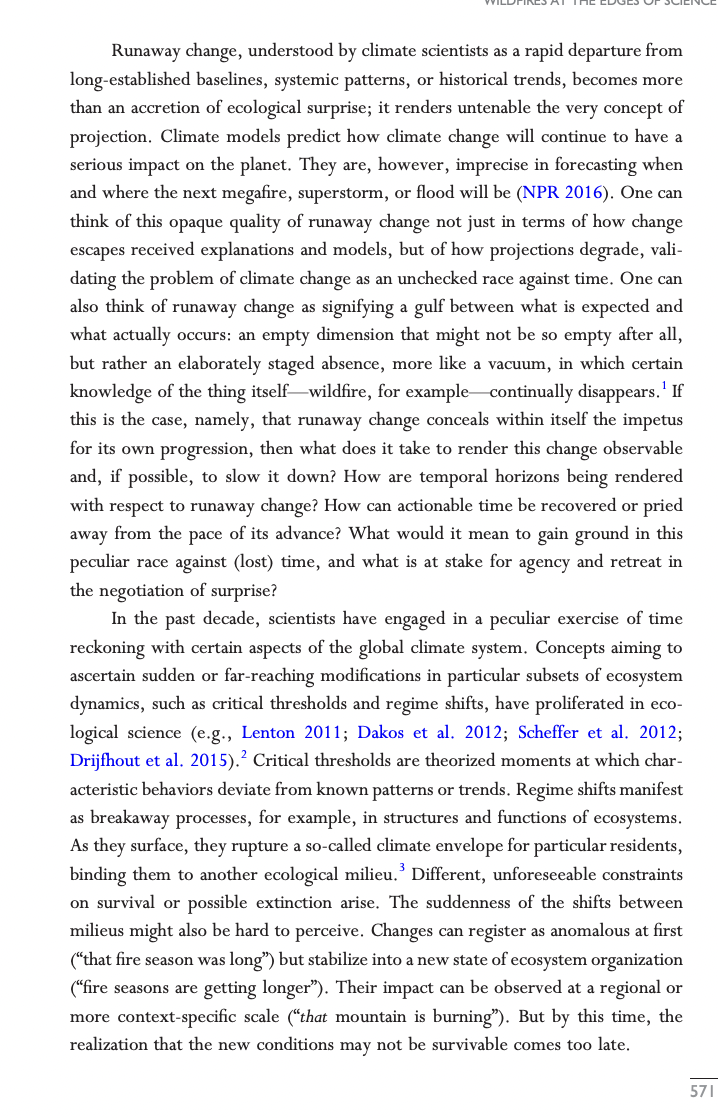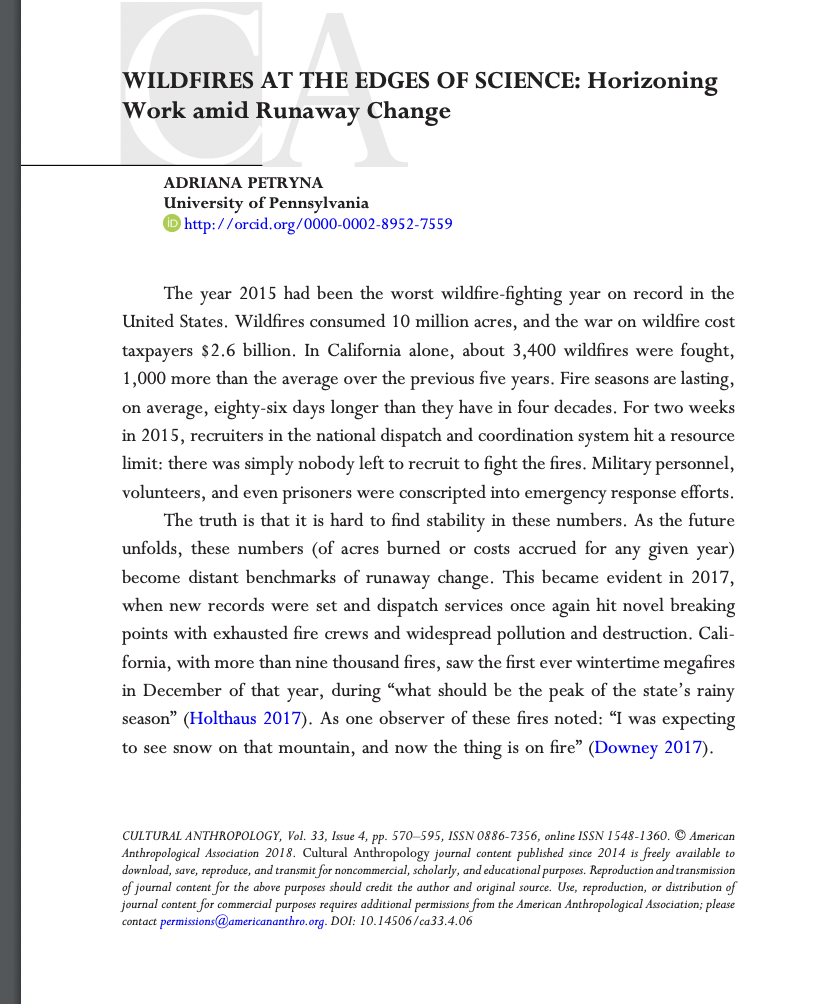I need help finding the argument and what the author is talking about in this book and help other readers understand
I need help finding the argument and what the author is talking about in this book and help other readers understand
Applications and Investigations in Earth Science (9th Edition)
9th Edition
ISBN:9780134746241
Author:Edward J. Tarbuck, Frederick K. Lutgens, Dennis G. Tasa
Publisher:Edward J. Tarbuck, Frederick K. Lutgens, Dennis G. Tasa
Chapter1: The Study Of Minerals
Section: Chapter Questions
Problem 1LR
Related questions
Question
I need help finding the argument and what the author is talking about in this book and help other readers understand
WILDFIRES AT THE EDGES OF SCIENCE: Horizoning
Work amid Runaway Change
ADRIANA PETRYNA

Transcribed Image Text:Runaway change, understood by climate scientists as a rapid departure from
long-established baselines, systemic patterns, or historical trends, becomes more
than an accretion of ecological surprise; it renders untenable the very concept of
projection. Climate models predict how climate change will continue to have a
serious impact on the planet. They are, however, imprecise in forecasting when
and where the next megafire, superstorm, or flood will be (NPR 2016). One can
think of this opaque quality of runaway change not just in terms of how change
escapes received explanations and models, but of how projections degrade, vali-
dating the problem of climate change as an unchecked race against time. One can
also think of runaway change as signifying a gulf between what is expected and
what actually occurs: an empty dimension that might not be so empty after all,
but rather an elaborately staged absence, more like a vacuum, in which certain
knowledge of the thing itself wildfire, for example continually disappears. If
this is the case, namely, that runaway change conceals within itself the impetus
for its own progression, then what does it take to render this change observable
and, if possible, to slow it down? How are temporal horizons being rendered
with respect to runaway change? How can actionable time be recovered or pried
away from the pace of its advance? What would it mean to gain ground in this
peculiar race against (lost) time, and what is at stake for agency and retreat in
the negotiation of surprise?
In the past decade, scientists have engaged in a peculiar exercise of time
reckoning with certain aspects of the global climate system. Concepts aiming to
ascertain sudden or far-reaching modifications in particular subsets of ecosystem
dynamics, such as critical thresholds and regime shifts, have proliferated in eco-
logical science (e.g., Lenton 2011; Dakos et al. 2012; Scheffer et al. 2012;
Drijfhout et al. 2015).² Critical thresholds are theorized moments at which char-
acteristic behaviors deviate from known patterns or trends. Regime shifts manifest
as breakaway processes, for example, in structures and functions of ecosystems.
As they surface, they rupture a so-called climate envelope for particular residents,
binding them to another ecological milieu.³ Different, unforeseeable const
on survival or possible extinction arise. The suddenness of the shifts between
milieus might also be hard to perceive. Changes can register as anomalous at first
("that fire season was long") but stabilize into a new state of ecosystem organization
("fire seasons are getting longer"). Their impact can be observed at a regional or
more context-specific scale ("that mountain is burning"). But by this time, the
realization that the new conditions may not be survivable comes too late.
571

Transcribed Image Text:WILDFIRES AT THE EDGES OF SCIENCE: Horizoning
Work amid Runaway Change
ADRIANA PETRYNA
University of Pennsylvania
D http://orcid.org/0000-0002-8952-7559
The year 2015 had been the worst wildfire-fighting year on record in the
United States. Wildfires consumed 10 million acres, and the war on wildfire cost
taxpayers $2.6 billion. In California alone, about 3,400 wildfires were fought,
1,000 more than the average over the previous five years. Fire seasons are lasting,
on average, eighty-six days longer than they have in four decades. For two weeks
in 2015, recruiters in the national dispatch and coordination system hit a resource
limit: there was simply nobody left to recruit to fight the fires. Military personnel,
volunteers, and even prisoners were conscripted into emergency response efforts.
The truth is that it is hard to find stability in these numbers. As the future
unfolds, these numbers (of acres burned or costs accrued for any given year)
become distant benchmarks of runaway change. This became evident in 2017,
when new records were set and dispatch services once again hit novel breaking
points with exhausted fire crews and widespread pollution and destruction. Cali-
fornia, with more than nine thousand fires, saw the first ever wintertime megafires
in December of that year, during "what should be the peak of the state's rainy
season" (Holthaus 2017). As one observer of these fires noted: "I was expecting
to see snow on that mountain, and now the thing is on fire" (Downey 2017).
CULTURAL ANTHROPOLOGY, Vol. 33, Issue 4, pp. 570-595, ISSN 0886-7356, online ISSN 1548-1360. © American
Anthropological Association 2018. Cultural Anthropology journal content published since 2014 is freely available to
download, save, reproduce, and transmit for noncommercial, scholarly, and educational purposes. Reproduction and transmission
of journal content for the above purposes should credit the author and original source. Use, reproduction, or distribution of
journal content for commercial purposes requires additional permissions from the American Anthropological Association; please
contact permissions@americananthro.org. DOI: 10.14506/ca33.4.06
Expert Solution
This question has been solved!
Explore an expertly crafted, step-by-step solution for a thorough understanding of key concepts.
Step by step
Solved in 2 steps

Recommended textbooks for you

Applications and Investigations in Earth Science …
Earth Science
ISBN:
9780134746241
Author:
Edward J. Tarbuck, Frederick K. Lutgens, Dennis G. Tasa
Publisher:
PEARSON

Exercises for Weather & Climate (9th Edition)
Earth Science
ISBN:
9780134041360
Author:
Greg Carbone
Publisher:
PEARSON

Environmental Science
Earth Science
ISBN:
9781260153125
Author:
William P Cunningham Prof., Mary Ann Cunningham Professor
Publisher:
McGraw-Hill Education

Applications and Investigations in Earth Science …
Earth Science
ISBN:
9780134746241
Author:
Edward J. Tarbuck, Frederick K. Lutgens, Dennis G. Tasa
Publisher:
PEARSON

Exercises for Weather & Climate (9th Edition)
Earth Science
ISBN:
9780134041360
Author:
Greg Carbone
Publisher:
PEARSON

Environmental Science
Earth Science
ISBN:
9781260153125
Author:
William P Cunningham Prof., Mary Ann Cunningham Professor
Publisher:
McGraw-Hill Education

Earth Science (15th Edition)
Earth Science
ISBN:
9780134543536
Author:
Edward J. Tarbuck, Frederick K. Lutgens, Dennis G. Tasa
Publisher:
PEARSON

Environmental Science (MindTap Course List)
Earth Science
ISBN:
9781337569613
Author:
G. Tyler Miller, Scott Spoolman
Publisher:
Cengage Learning

Physical Geology
Earth Science
ISBN:
9781259916823
Author:
Plummer, Charles C., CARLSON, Diane H., Hammersley, Lisa
Publisher:
Mcgraw-hill Education,